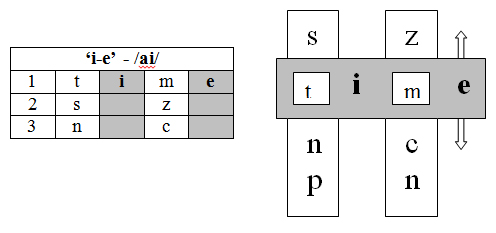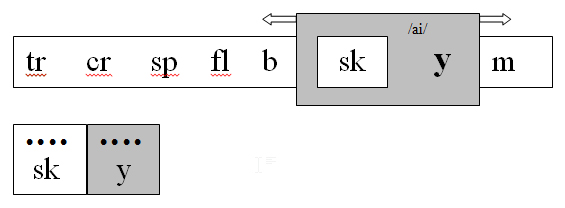 Spelling mistakes constitute a notorious feature of dyslexic writing. Teachers often highlight or circle the mistakes (especially with a red pen) bringing them to the surface of the text but in that way students focus their attention on and consolidate the erroneous forms instead of learning the correct spelling.
Spelling mistakes constitute a notorious feature of dyslexic writing. Teachers often highlight or circle the mistakes (especially with a red pen) bringing them to the surface of the text but in that way students focus their attention on and consolidate the erroneous forms instead of learning the correct spelling.
Other tried-and-tested methods can also cause more harm than good
In a similar vein, writing the words on the blackboard and asking students to compare them with their own spelling attempts does not work very well with dyslexic learners.
The occurrence of mistakes is sometimes indicated on the margin in a given line of the text; however, if we do not specify where exactly the mistake is, we make the correcting task much harder for our dyslexic students.
Another technique is to simply count down the mistakes and give the total at the bottom of the text, often with no indication of the exact position of the mistakes. Unfortunately, even very careful looking at words and searching for mistakes cannot guarantee identifying the misspelt ones, just the opposite, it happens that perfectly well-spelt words get ‘corrected’ mistakenly.
So, what works?
It proves much more effective and less time-consuming to cross the misspelt word and write the correct spelling above or next to it. In that way, it is the correct form that is made visible and, hopefully, integrated.
What else?
Difficult words to spell require decent practice, frequent repetition and consolidation – much more than would seem standard. However, mechanical repetition (e.g. spelling a word a hundred times) seems rather useless, it evokes boredom and decreases motivation. Students tend not to concentrate and often rewrite the practised words with mistakes.
To make the task more interesting, we may model the sound-letter structure of words with:
- the use of tokens
- finger tracing of letters and words on various surfaces
- colour-coded card sorting with simultaneous verbalising of the orthographic rules.
These activities can be followed by blackboard drills, regular paper-pencil tasks and games. Forming word families for the misspelt words, designing mnemonics and multisensory movable devices which involve the kinaesthetic-tactile elements of learning and enormously enhance remembering helps to anchor the correct spelling in memory.
Below are some examples of movable teaching aids for practising the spelling of /ai/ in English. Words are grouped into families sharing a given spelling pattern.
- Students manipulate a movable device comprising three piles of cards. Piles are joined at the top with a spring to form words containing /ai/, spelt with ‘igh’ in the middle. They read and spell the words.

- Students manipulate word slides to form words. They read and write the words down.

- Words containing the /ai/ sound spelt with the ‘i-e’ letter pattern.

- Words containing the /ai/ sound spelt with the letter ‘-y’ at the end.

Joanna Nijakowska is Assistant Professor at the Institute of English at the University of ?ód?, Poland. A specialist in psycholinguistics, foreign language acquisition and didactics, and learning difficulties, she runs teacher training courses for ELT students and practitioners. She has authored and edited books and papers on EFL and dyslexia, presenting her research at European and American academic centers. Joanna authored Dyslexia in the Foreign Language Classroom in 2010.


Thank you very much for your ideas.
There are many kids with dyslexia, and I read about types of exercies and other tips that can help, but this is the first time I see something about correcting spelling.
thanks,
mercedes
Thank you for this interesting article. Although I don’t work specifically with dyslexic learners, I find the best way with weak spellers is to write the word above what they have written but leave blanks for the letters that they have got wrong. So if a student writes ‘becuas’, above it I write
‘bec _ _ s _’.
Actually I’ve written a detailed blog post about correcting spelling (which is also a chapter from my book ‘Teaching Spelling to English Language Learners’) on The Spelling Blog: https://thespellingblog.blogspot.com/2010/11/how-to-correct-spelling-12-ways.html
Johanna
I was very impressed when my 6 year old spelled ‘because’ correctly – and then he let me in on a secret: Big Elephants Can Always Understand Small Elephants. That was in L1 classroom context, but I guess the use of mnemonics like these can also sometimes work in ELT.
I always think mnemonics should be used as a last resort. They undoubtedly allow you to produce the correct spelling but I’m not sure they help you really learn that spelling – I mean the you don’t gain automaticity when spelling that word. I could never spell the word ‘rhythm’ until I learnt ‘Rhythm Helps Your Two Hips Move’, but now I always have to say that to myself to spell the word.
But if there’s no other way to remember – they’re great.
Johanna
betty eats carrots and uncle sucks eggs is another one, it worked well with my daughter:)
I am very impressed for your post. Your ideas very useful for me.